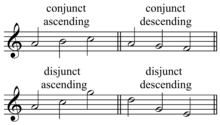Melodic motion
Appearance

Melodic motion is the quality of movement of a melody, including nearness or farness of successive pitches or notes in a melody. This may be described as conjunct or disjunct, stepwise or skipwise, respectively. See also contrapuntal motion.
Bruno Nettl describes various types of melodic movement or contour (Nettl 1956, 51–53):
- Ascending
- Descending
- Undulating: equal movement in both of the above directions
- Pendulum: extreme undulation which uses a large range and large intervals
- Tile, terrace, or cascading: a number of descending phrases in which each phrase begins on a higher pitch than the last ended
- Arc
- Rise: may be considered a musical form, a contrasting section of higher pitch, a "musical plateau".
Other examples include:
- Double tonic: smaller pendular motion in one direction
These all may be modal frames or parts of modal frames.
See also
Source
- Nettl, Bruno (1956). Music in Primitive Culture. Harvard University Press.
